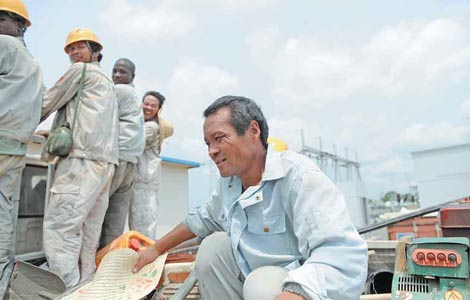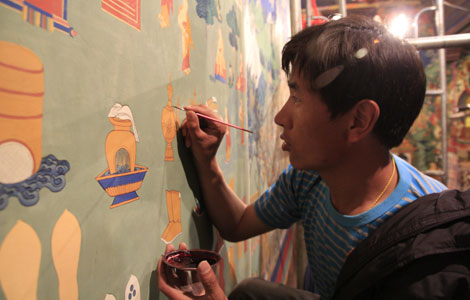Terraces on top of the world
Updated: 2013-07-26 06:35
By Hu Yongqi and Li Yingqing (China Daily)
|
|||||||||||
Food for thought
Dayutang's six restaurants were built in 2009 with the support of the prefecture government via an interest-free loan of 100,000 yuan and a one-time stipend of 30,000 yuan.
Since it opened, Li's restaurant has catered to a wide range of visitors, who carry high-quality cameras to take photos of the terraces next to the house. The food is either his own produce or is purchased from neighbors, ensuring the fare is "100 percent natural and no chemicals are used".
Local dishes, such as buckwheat cakes, take pride of place at the top of the menus. Eels and loaches are also popular dishes. They mature in the rice fields but are "not fed contraceptives (which increase body mass) in aquaculture farms", according to the villagers.
"I used to work in distant towns and cities, but I was unable to take care of my children. Now things have changed and I don't want to leave my family, so I focus on producing the best food I can," said Li.
The clean, tidy village looked vastly different in the old days, when the pigs wandered free and their droppings covered the dirt road. The power supply was unstable and the 50 houses were so outdated and filthy that visitors would not approach them, despite the delicious food on offer.
The dilapidation was so bad that the local tourist bureau organized a series of training sessions for the villagers and now the houses, all boasting traditional mushroom-shaped ceilings, are spotlessly clean. Cows and pigs are kept in specially erected sheds.
However, it's a slow process and 73 other villages in the scenic area have yet to embrace change. Once the rice is planted safely in early June, the workers travel far and wide to earn additional income, only returning for the harvest in late September.
In the past, roughly one-third of Dayutang's labor force migrated to cities, such as the prefecture capital, Mengzi, for temporary work, a common practice in rural areas. In 2012, the annual per capita net income for farmers in Yuanyang was 3,600 yuan. Although that's an increase of more than 100 percent from 2007, the figure is still just half the national average.
"The most important thing for the Hani terraces is to keep the farmers on the land. Only in this way can the legacy be upheld and the culture displayed," said Zhang.
Lu of the tourism authority said the "treasure" would have been ruined if the farmers had left their homes to seek work in other areas.
To that end, the bureau initiated the "Beautiful Homes Project" to help residents provide food and accommodation for visitors. By 2020, every household in the terraces' scenic area will serve food and have at least one bed for visitors.
Yuanyang government said the scenic area will receive around 10,000 visitors a day and more accommodation will be required. At present, centers such as the townships of Xinjie and Nansha have just 5,000 beds. Houses will be rebuilt in 73 villages, including Xiaolinggang. Li Zhiguang, the village head, said the 51 households were each given a stipend of 30,000 yuan and the residents are looking forward to seeing the new accommodation and welcoming visitors into their homes.
Li Zhengfu is confident tourism will benefit the area and is determined to emulate his ancestors by staying on the terraces and protecting his heritage. "We will try our best to maintain the terraces, but who knows what will happen if too many visitors arrive?" he mused.
Guo Anfei contributed to this story.
Contact the writer at huyongqi@chinadaily.com.cn
Related Stories
Leave a moment of peace for the Hani Terrace 2013-07-15 11:06
Hani terrace:a new World Heritage sitexia 2013-06-28 11:38
Stunning photos of Hani terrace 2013-06-26 16:13
Stunning photos of Hani terrace 2013-06-26 16:13
Hani terraces named UNESCO world heritage 2013-06-26 15:20
Hani terrace:a new World Heritage sitexia 2013-06-24 13:03
Today's Top News
Indictment shows CPC's stance on corruption
Japanese PM unlikely to visit Yasukuni Shrine
Top DPRK leader meets Chinese vice-president
FDI to maintain growth in H2
EU 'students' get access to Chinese culture
Girl, 2, thrown to ground; suspect detained
New industries lead job growth
Crackdown a bitter drug to herald changes
Hot Topics
Lunar probe , China growth forecasts, Emission rules get tougher, China seen through 'colored lens', International board,
Editor's Picks

|

|

|

|

|

|





